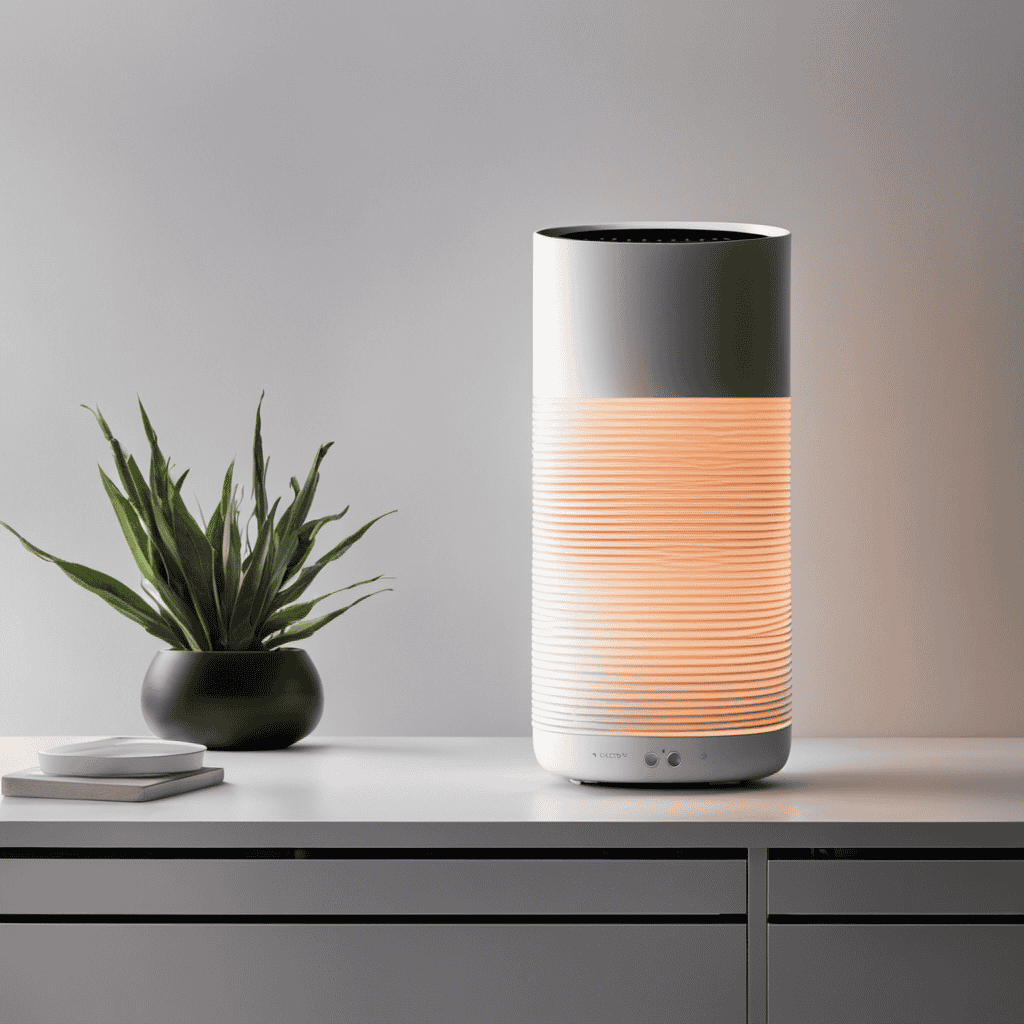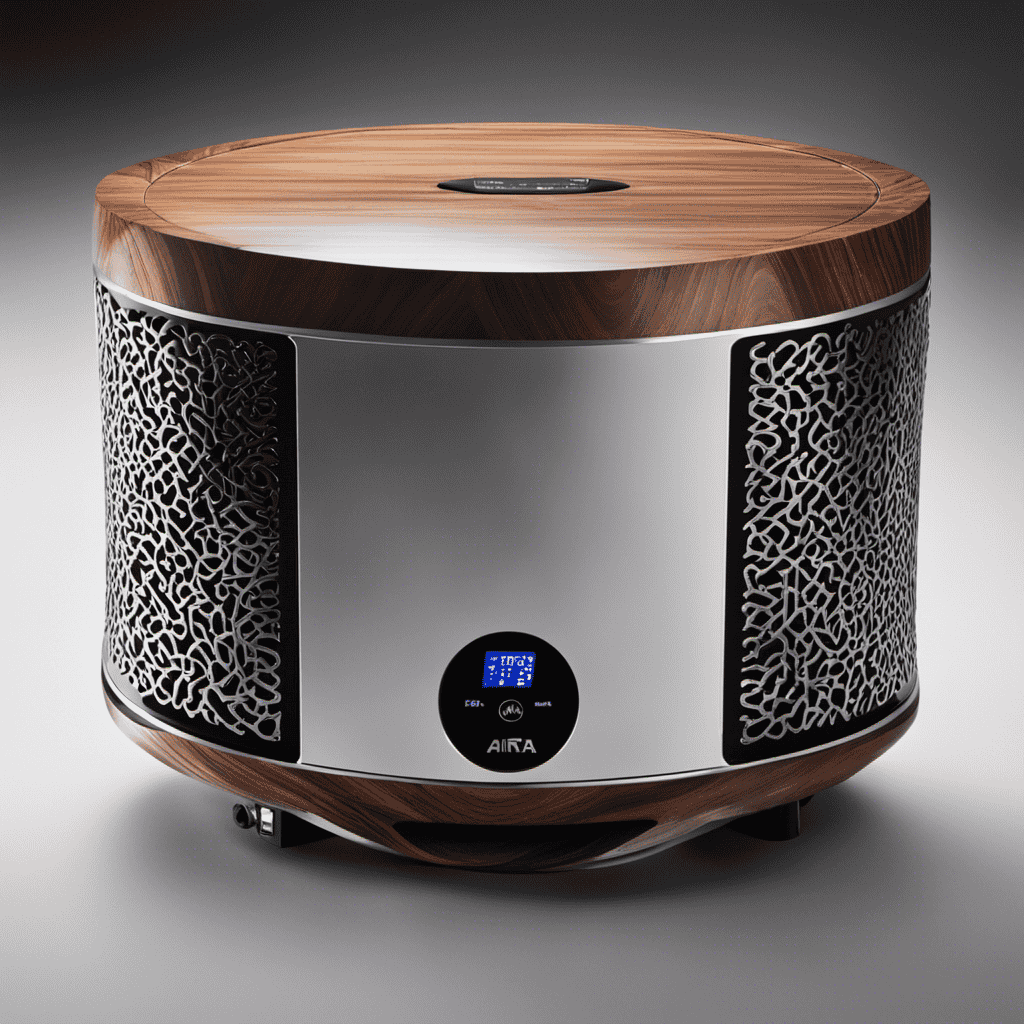As an individual who prioritizes clean and fresh air, I can confirm the significance of owning an air purifier. It’s comparable to having a dedicated protector that effectively eliminates detrimental pollutants and allergens from your indoor surroundings.
Breathing in clean air not only improves your respiratory health but also enhances your overall well-being.
In this article, we will explore the myriad benefits of air purifiers, from reducing odors to alleviating allergies, and even improving sleep quality.
Let’s dive into the world of air purification and unlock its potential for a healthier lifestyle.
Key Takeaways
- Air purifiers play a crucial role in maintaining indoor air quality and reducing the concentration of indoor pollutants.
- Poor air quality can negatively affect respiratory health and lead to asthma, allergies, COPD, and respiratory infections.
- Air purifiers can reduce allergens, improve respiratory health, and create a cleaner and healthier living environment.
- Air purifiers are effective in removing harmful pollutants, eliminating odors, and reducing the risk of respiratory infections.
The Role of Air Purifiers in Maintaining Indoor Air Quality
Air purifiers play a crucial role in maintaining indoor air quality. Indoor pollutants, such as dust, pet dander, mold spores, and volatile organic compounds (VOCs), can significantly affect our respiratory health. These pollutants can aggravate allergies, trigger asthma attacks, and cause respiratory symptoms in healthy individuals.
Air purifiers work by filtering the air and removing these harmful particles, thereby reducing the concentration of indoor pollutants. They use filters, such as HEPA filters, activated carbon filters, or electrostatic precipitators, to capture and trap these pollutants.
Understanding the Impact of Poor Air Quality on Health
Breathing in polluted air can negatively affect our health, leading to various respiratory issues. The impact of air pollution on our well-being cannot be underestimated. Indoor air contaminants are a major concern, as we spend most of our time indoors. These contaminants can come from various sources such as cooking, cleaning products, tobacco smoke, and building materials.
To better understand the impact of poor air quality on health, let’s take a look at the following table:
| Health Effects of Indoor Air Contaminants | Symptoms |
|---|---|
| Asthma | Wheezing, shortness of breath, coughing |
| Allergies | Sneezing, runny nose, itchy eyes |
| Chronic Obstructive Pulmonary Disease (COPD) | Difficulty breathing, coughing, chest tightness |
| Respiratory Infections | Coughing, sore throat, congestion |
As you can see, exposure to indoor air contaminants can lead to a range of health issues. These pollutants can trigger or worsen existing respiratory conditions, and even increase the risk of developing lung cancer. Therefore, it is crucial to take measures to improve indoor air quality, such as using air purifiers, to reduce the impact of air pollution on our health.
How Air Purifiers Can Reduce Allergens and Improve Respiratory Health
By using an air purifier, you’ll notice a significant reduction in allergens and an improvement in your respiratory health. Air purifiers play a crucial role in removing indoor pollutants, which can have detrimental effects on our health.
Here are some key ways in which air purifiers can benefit you:
- Filter out airborne particles such as dust, pollen, pet dander, and mold spores.
- Remove harmful chemicals and volatile organic compounds (VOCs) from the air.
- Decrease the risk of respiratory illnesses such as asthma and allergies.
- Improve indoor air quality, especially in spaces with poor ventilation.
- Create a cleaner and healthier living environment for you and your family.
By investing in an air purifier, you can enjoy cleaner air and reduce the risk of respiratory ailments caused by indoor pollutants.
Now, let’s delve into the benefits of air purifiers in removing harmful pollutants.
The Benefits of Air Purifiers in Removing Harmful Pollutants
Using an air purifier can greatly reduce the presence of harmful pollutants in your indoor environment. Air purifiers work by filtering out particles and contaminants from the air, improving air quality and reducing the risk of respiratory issues. These devices are especially beneficial for individuals with allergies, asthma, or other respiratory conditions. By removing pollutants such as dust, pollen, pet dander, mold spores, and volatile organic compounds (VOCs), air purifiers create a healthier and more comfortable living space. The table below provides a comparison of different types of air purifiers based on their effectiveness in removing pollutants. It is important to choose an air purifier that suits your specific needs and room size to ensure optimal results. Investing in an air purifier is a wise choice for improving the air quality in your home or office environment.
| Type of Air Purifier | Filter Type | Effectiveness in Removing Pollutants |
|---|---|---|
| HEPA | HEPA | High |
| Activated Carbon | Carbon | Moderate |
| Ionizer | Ionization | Low |
The Importance of Air Purifiers in Eliminating Odors and Improving Indoor Smell
To eliminate odors and improve the smell of your indoor environment, you’ll want to consider investing in an air purifier. Air purifiers are an effective way to remove unpleasant odors and improve indoor air quality. Here are some key benefits of using an air purifier:
-
Eliminates Odors: Air purifiers are equipped with filters that can capture and eliminate odorous particles, such as pet dander, smoke, and cooking smells.
-
Filters Harmful Chemicals: Air purifiers can remove harmful chemicals and VOCs (volatile organic compounds) from the air, which can contribute to bad odors.
-
Reduces Allergens: Air purifiers can trap allergens like pollen, dust mites, and mold spores, reducing their presence in the air and improving air quality.
-
Improves Respiratory Health: By removing airborne pollutants, air purifiers can help reduce respiratory issues like allergies, asthma, and sinus problems.
-
Creates a Fresh Indoor Environment: With odors eliminated and air quality improved, air purifiers can create a fresh and pleasant-smelling indoor environment.
Investing in an air purifier is a practical way to eliminate odors and improve indoor air quality, ensuring a healthier and more enjoyable living space.
Air Purifiers and Their Role in Reducing the Risk of Respiratory Infections
Reducing the risk of respiratory infections is a key role that air purifiers play in maintaining a healthy indoor environment. Air purifiers are effective in reducing viral transmission by eliminating airborne particles that can carry viruses and bacteria. These devices use various filtration methods, including HEPA filters, activated carbon filters, and UV-C light technology, to capture and destroy harmful microorganisms.
HEPA filters have been proven to be highly effective in trapping particles as small as 0.3 microns, including many viruses and bacteria. Additionally, activated carbon filters help remove odors and chemical pollutants from the air. UV-C light technology can also kill bacteria and viruses by damaging their DNA and RNA.
Multiple studies have demonstrated the air purification effectiveness in reducing the concentration of airborne viruses and reducing the risk of respiratory infections in indoor environments. Therefore, investing in an air purifier can provide an added layer of protection against respiratory infections and promote a healthier living space.
How Air Purifiers Can Help With Asthma and Allergies
As someone who suffers from asthma, I’ve found that air purifiers can provide significant relief.
These devices are designed to remove airborne particles and allergens from the air, reducing the triggers that can cause asthma symptoms.
Additionally, air purifiers can also help with allergy reduction by capturing and trapping allergens such as pollen, dust mites, and pet dander.
This can alleviate symptoms for individuals with allergies.
The benefits of air purifiers extend beyond asthma and allergies.
They can also improve overall indoor air quality and promote a healthier living environment.
Asthma Relief With Purifiers
Using an air purifier can help you find relief from asthma symptoms. As someone who suffers from asthma, I’ve found that incorporating an air purifier into my daily routine has greatly improved my quality of life.
Here are some reasons why air purifiers are essential for asthma management and air quality improvement:
-
Air purifiers remove airborne allergens and irritants, such as dust mites, pollen, pet dander, and mold spores, which can trigger asthma attacks.
-
They filter out harmful pollutants, including volatile organic compounds (VOCs), smoke particles, and chemical fumes, improving indoor air quality.
-
By capturing and trapping airborne particles, air purifiers reduce the number of asthma triggers circulating in the air, providing a cleaner and healthier environment.
-
Air purifiers can help alleviate asthma symptoms, such as coughing, wheezing, and shortness of breath, by reducing exposure to irritants.
-
Regular use of air purifiers can prevent long-term damage to the respiratory system and improve overall lung function, enhancing asthma management.
Allergy Reduction Through Purification
If you suffer from allergies, incorporating an air purifier into your daily routine can greatly reduce the presence of allergens in your home or workspace. Air purifiers are designed to filter out pollutants and particles from the air, including common allergens such as pollen, dust mites, and pet dander.
These allergens can trigger respiratory conditions and worsen symptoms for individuals with allergies. By removing these allergens from the air, air purifiers create a cleaner and healthier indoor environment, which can provide relief for those suffering from respiratory conditions.
Indoor pollution is a significant concern, as studies have shown that indoor air can be up to five times more polluted than outdoor air. Air purifiers play a crucial role in combating indoor pollution, improving air quality, and ultimately benefiting our overall health and well-being.
With the reduction of allergens and pollutants, individuals can experience improved respiratory function and fewer allergy-related symptoms.
Benefits of Air Purifiers
To fully reap the benefits, you should regularly clean and maintain your air purifier. This ensures that it continues to function optimally and effectively improve the quality of the air in your space.
Here are some key reasons why air purifier maintenance is crucial:
- Prolongs the lifespan of your air purifier, saving you money in the long run.
- Prevents the accumulation of dust and debris, which can hinder its performance.
- Keeps the filters clean and functional, ensuring efficient removal of allergens and pollutants.
- Reduces the risk of mold and bacteria growth within the unit.
- Maintains the effectiveness of advanced air purifier technologies, such as HEPA filters and activated carbon filters.
The Connection Between Air Purifiers and Better Sleep Quality
Investing in an air purifier can improve your sleep quality. By reducing allergens and pollutants in the air you breathe at night, air purifiers create a cleaner and healthier sleep environment. They are designed to filter out particles like dust, pollen, pet dander, and mold spores, which can trigger allergies and respiratory issues. Studies have shown that individuals with allergies and asthma experience reduced symptoms and better sleep when using air purifiers. Air purifiers can also provide relief for those suffering from insomnia. The white noise generated by some air purifiers can help mask disruptive sounds, promoting a more peaceful and uninterrupted sleep. Overall, incorporating an air purifier into your bedroom can significantly enhance your sleep experience and contribute to better overall health.
Air Purifiers for Pet Owners: Reducing Pet Dander and Allergens in the Air
For pet owners, using an air purifier can significantly decrease the amount of pet dander and allergens in the air. This is especially important for individuals who suffer from allergies or asthma. Here are some key reasons why air purifiers are beneficial for pet owners:
-
Reducing shedding: Air purifiers with HEPA filters can effectively capture pet hair and dander, reducing the amount of allergens in the air.
-
Eliminating odors: Some air purifiers are equipped with activated carbon filters that can help eliminate pet odors, keeping your home smelling fresh.
-
Pet friendly technology: Many air purifiers are designed with pet owners in mind, featuring quiet operation and pet-safe materials.
-
Improving indoor air quality: By removing pet dander, dust, and other particles from the air, air purifiers can improve overall indoor air quality, creating a healthier environment for both you and your pets.
-
Preventing respiratory issues: By reducing the amount of pet allergens in the air, air purifiers can help prevent respiratory issues and alleviate symptoms for individuals with allergies or asthma.
Investing in a high-quality air purifier is a wise decision for pet owners, as it can greatly improve the air quality in your home and reduce the risk of allergic reactions or respiratory problems caused by pet dander and allergens.
How Does a Pre Filter in an Air Purifier Contribute to Its Importance?
A pre filter in an air purifier serves the purpose of catching larger particles like dust, pet hair, and lint before they reach the main filter. This contributes to the overall importance of the air purifier by extending the lifespan of the main filter and improving the air quality in the environment.
The Long-Term Cost Savings of Having an Air Purifier
Having an air purifier in your home not only provides numerous health benefits but also offers long-term cost savings.
The financial benefits of having an air purifier are significant, as it helps to improve the overall air quality and reduce the need for costly medical treatments.
Additionally, by removing pollutants and allergens from the air, air purifiers can prevent respiratory illnesses and promote improved health outcomes for individuals and their families.
Financial Benefits of Purifier
One of the financial benefits of an air purifier is that it can help save on energy costs. This is due to its energy efficiency, which allows it to operate with minimal power consumption. Here are some ways an air purifier can contribute to financial savings:
- Energy-efficient design reduces electricity usage
- Automatic sensors optimize energy usage based on air quality
- Timer settings allow you to schedule operation during off-peak hours
- Filter replacement indicators prevent unnecessary filter changes
- Improved air quality reduces the need for HVAC system maintenance and repairs
By taking advantage of these features, you can enjoy the financial benefits of reduced energy costs while ensuring a healthier indoor environment.
Now, let’s explore how an air purifier can lead to improved health outcomes.
Improved Health Outcomes
As I mentioned earlier, air purifiers not only bring financial benefits, but they also have a significant impact on our health outcomes.
One of the key advantages of using an air purifier is the improvement it brings to our immune system. Research has shown that air purifiers can effectively remove harmful pollutants and allergens from the air, reducing our exposure to these substances. By breathing in cleaner air, our immune system is better able to function properly and fight off infections and diseases.
Additionally, air purifiers can also help in reducing respiratory symptoms. For individuals suffering from conditions such as asthma or allergies, air purifiers can provide relief by removing triggers like dust mites, pollen, and pet dander from the air. This can lead to a decrease in symptoms such as coughing, wheezing, and sneezing, improving overall respiratory health.
Conclusion
In conclusion, having an air purifier is absolutely crucial for maintaining a healthy indoor environment. It not only improves the air quality but also has a profound impact on our overall well-being.
With the ability to reduce allergens, remove harmful pollutants, eliminate odors, and even help with asthma and allergies, air purifiers provide a breath of fresh air in our homes. They create a serene sanctuary where we can sleep peacefully, free from the clutches of pet dander and allergens.
Investing in an air purifier is a wise decision that guarantees long-term cost savings and a healthier, happier life.










